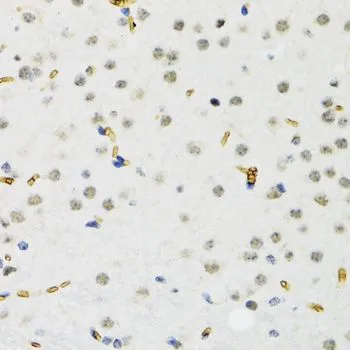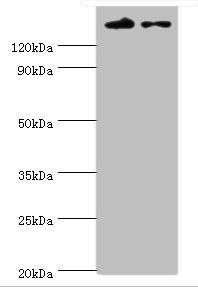
WB analysis of 293T cell lysate using GTX33492 SETDB1 antibody. Dilution : 1:1000 Loading : 25microg per lane
SETDB1 antibody
GTX33492
ApplicationsWestern Blot, ImmunoHistoChemistry, ImmunoHistoChemistry Paraffin
Product group Antibodies
TargetSETDB1
Overview
- SupplierGeneTex
- Product NameSETDB1 antibody
- Delivery Days Customer9
- Application Supplier NoteWB: 1:500 - 1:2000. IHC-P: 1:50 - 1:100. *Optimal dilutions/concentrations should be determined by the researcher.Not tested in other applications.
- ApplicationsWestern Blot, ImmunoHistoChemistry, ImmunoHistoChemistry Paraffin
- CertificationResearch Use Only
- ClonalityPolyclonal
- ConjugateUnconjugated
- Gene ID9869
- Target nameSETDB1
- Target descriptionSET domain bifurcated histone lysine methyltransferase 1
- Target synonymsESET, H3-K9-HMTase4, KG1T, KMT1E, TDRD21, histone-lysine N-methyltransferase SETDB1, ERG-associated protein with a SET domain, ESET, SET domain bifurcated 1, histone H3-K9 methyltransferase 4, histone-lysine N-methyltransferase, H3lysine-9 specific 4, lysine N-methyltransferase 1E, tudor domain containing 21
- HostRabbit
- IsotypeIgG
- Protein IDQ15047
- Protein NameHistone-lysine N-methyltransferase SETDB1
- Scientific DescriptionThis gene encodes a histone methyltransferase which regulates histone methylation, gene silencing, and transcriptional repression. This gene has been identified as a target for treatment in Huntington Disease, given that gene silencing and transcription dysfunction likely play a role in the disease pathogenesis. Alternatively spliced transcript variants of this gene have been described.[provided by RefSeq, Jun 2011]
- Storage Instruction-20°C or -80°C,2°C to 8°C
- UNSPSC12352203




![ICC/IF analysis of LOVO cells using GTX80408 SETDB1 antibody [5H6A12]. Green : SETDB1 Red: Actin filaments](https://www.genetex.com/upload/website/prouct_img/normal/GTX80408/GTX80408_20170912_ICCIF_w_23061322_696.webp)
![WB analysis of MCF-7 (1),T47D (2), HEK293 (3), JURKAT (4), NIH3T3 (5) and F9 (6) cell lysate using GTX80409 SETDB1 antibody [5H6D4].](https://www.genetex.com/upload/website/prouct_img/normal/GTX80409/GTX80409_20170912_WB_w_23061322_503.webp)